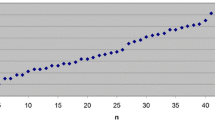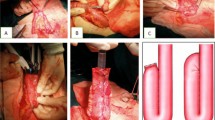Abstract
Introduction
Restorative proctocolectomy and ileal pouch-anal reconstruction is the surgical standard for the majority of patients with familial adenomatous polyposis (FAP). The pouch-anal anastomosis may be performed handsewn after primary mucosectomy or by double stapling. Better functional results favour the latter; however, higher rates of remaining rectal mucosa with adenomas often necessitate secondary mucosectomy. Data on functional outcome after secondary mucosectomy is scarce. The aim of the study was to analyse whether patients who undergo secondary mucosectomy maintain their functional benefits compared to patients with primary mucosectomy.
Patients and methods
Twenty patients after secondary mucosectomy and 31 patients after primary mucosectomy were compared with respect to their functional outcome, using the MSKCC score, the Wexner score and ano-rectal physiology testing.
Results
The MSKCC global score and the Wexner score showed a non-significant trend towards slightly better results after secondary mucosectomy (63.1 vs. 56.6, p = 0.0188 and 9.5 vs. 11, p = 0.3780). Patients after secondary mucosectomy also showed a tendency towards less bowel movements per 24 h (7 (range 4–11) vs. 8.5 (range 3–20), p = 0.1518). Resting pressures were slightly higher after secondary (44 vs. 39.6 mmHg, p = 0.4545) and squeeze pressures slightly higher after primary mucosectomy (87.6 vs. 81.2 mmHg, p = 0.6126). However, the results did not reach statistical significance.
Conclusion
The results of this study cannot ultimately resolve the controversy concerning handsewn versus stapled ileal pouch-anal anastomosis. Our results suggest a trend towards better functional results after stapled anastomosis with secondary mucosectomy.


Similar content being viewed by others
References
Kadmon M (2005) Prophylactic surgery for patients with familial adenomatous polyposis coli. Chirurg 76:1125–1134
Kartheuser A, Stangherlin P, Brandt D, Remue C, Sempoux C (2006) Restorative proctocolectomy and ileal pouch-anal anastomosis for familial adenomatous polyposis revisited. Familial Cancer 5:241–260
Lovegrove RE, Constantinides VA, Heriot AG et al (2006) A comparison of hand-sewn versus stapled ileal pouch anal anastomosis (IPAA) following proctocolectomy. A meta-analysis of 4183 patients. Ann Surg 1:18–26
Ganschow P, Pfeiffer U, Hinz U, Leowardi C, Herfarth C, Kadmon M (2010) Quality of life ten and more years after restorative proctocolectomy for patients with familial adenomatous polyposis coli (FAP). Dis Colon Rectum 53(10):1381–1387
Osterfeld ND, Kadmon M, Brechtel A, Keller M (2008) Preoperative and postoperative quality of life in patients with familial adenomatous polyposis. Dis Colon Rectum 51(9):1324–1330
Fazio VW, O’Riordain MG, Lavery IC, Church JM, Lau P, Strong SA, Hull T (1999) Long-term functional outcome and quality of life after stapled restorative proctocolectomy. Ann Surg 230:575–584
Parks AG, Nicholls RJ (1978) Proctocolectomy without ileostomy for ulcerative colitis. Br Med J 2:85–88
Heald RJ, Allen DR (1986) Stapled ileo-anal anastomosis: a technique to avoid mucosal proctectomy in the ileal pouch operation. Br J Surg 73:571–572
Remzi FH, Church JM, Bast J, Lavery IC, Strong SA, Hull TL, Harris GJC, Delaney CP, OʼRiordain MG, McGannon EA, Fazio VW (2001) Mucosectomy vs. stapled ileal pouch-anal anastomosis in patients with familial adenomatous polyposis. Dis Colon Rectum 44:1590–1596
Kirat HT, Remzi FH, Kiran RP, Fazio VW (2009) Comparison of outcomes after hand-sewn versus stapled ileal pouch-anal anastomosis in 3,109 patients. Surgery 146:723–730
Gozzetti G, Poggioli G, Marchetti F, Laureti S, Grazi GL, Mastrorilli M, Selleri S, Stocchi L, di Simone M (1994) Functional outcome in handsewn versus stapled ileal pouch-anal anastomosis. Am J Surg 168:325–329
Gemlo BT, Belmonte C, Wiltz O et al (1995) Functional assessment of ileal pouch-anal anastomotic techniques. Am J Surg 169:137142
Fazio VW, Ziv Y, Church JM, Oakley JR, Lavery IC, Milsom JW, Schroeder TK (1995) Ileal pouch-anal anastomoses, complications and function in 1005 patients. Ann Surg 222:120–127
Reilly WT, Pemberton JH, Wolff BG, Nivatvongs S, Devine RM, Litchy WJ, McIntyre PB (1997) Randomized prospective trial comparing ileal pouch-anal anastomosis performed by excising the anal mucosa to ileal pouch-anal anastomosis performed by preserving the anal mucosa. Ann Surg 225:666–677
Slors JF, Ponson AE, Taat CW et al (1995) Risk of residual rectal mucosa after proctocolectomy and ileal pouch-anal reconstruction with the double-stapling technique. Postoperative endoscopic follow-up study. Dis Colon Rectum 38:207–210
Duijvendijk van P, Vasen HFA, Bertario L et al (1999) Cumulative risk of developing polyps or malignancy at the ileal pouch-anal anastomosis in patients with familial adenomatous polyposis. J Gastrointest Surg 3:325–330
Remzi FH, Fazio VW, Delaney CP, Preen M, Ormsby A, Bast J, OʼRiordain MG, Strong SA, Church JM, Petras RE, Gramlich T, Lavery IC (2003) Dysplasia of the anal transitional zone after ileal pouch-anal anastomosis. Results of prospective evaluation after a minimum of ten years. Dis Colon Rectum 46:6–13
von Roon AC, Will OCC, Man RF, Neale KF, Phillips RKS, Nicholls RJ, Clark SK, Tekkis PP (2011) Mucosectomy with handsewn anastomosis reduces the risk of adenoma formation in the anorectal segment after restorative proctocolectomy for familial adenomatous polyposis. Ann Surg 253(2):314–317
Tsunoda A, Talbot IC, Nicholls RJ (1990) Incidence of dysplasia in the anorectal mucosa in patients having restorative proctocolectomy. Br J Surg 77:506–508
Ganschow P, Treiber I, Hinz U, Leowardi C, Büchler MW, Kadmon M (2014) Residual rectal mucosa after stapled versus handsewn ileal J-pouch-anal anastomosis in patients with familial adenomatous polyposis coli (FAP)—a critical issue. Langenbeck's Arch Surg 400(2):213–219
Herzig D, Hardiman K, Weise M, Yu N, Paquette I, Feingold DL, Steele SR (2017) The American Society of Colon and Rectal Surgeons clinical practice guidelines for the management of inherited polyposis syndromes. Dis Colon Rectum 60:881–894
Litzendorf ME, Stucchi AF, Wishnie S et al (2010) Completion mucosectomy for retained rectal mucosa following restorative proctocolectomy with double-stapled ileal pouch–anal anastomosis. J Gastrointest Surg 14:562–569
Temple LK, Bacik J, Savatta SG et al (2005) The development of a validated instrument to evaluate bowel function after sphincter-preserving surgery for rectal cancer. Dis Colon Rectum 48(7):1353–1365
Jorge JMN, Wexner SD (1993) Etiology and management of fecal incontinence. Dis Colon Rectum 36(1):77–97
Wheeler JMD, Banerjee A, Ahuja N, Jewell DP, Mortensen NJMC (2005) Long-term function after restorative proctocolectomy. Dis Colon Rectum 48:946–951
Wuthrich P, Gervaz P, Ambrosetti P et al (2009) Functional outcome and quality of life after restorative proctocolectomy and ileo-anal pouch anastomosis. Swiss Med Wkly 139:193–197
Helavirta I, Hyöty M, Huhtala H, Collin P, Aitola P (2018) Long-term functional outcome after restorative proctocolectomy. A cross-sectional study. Scand J Gastroenterol 22:1–5
Emmertsen KJ, Laurberg S, on behalf of the Rectal Cancer Function Study Group (2013) Impact of bowel dysfunction on quality of life after sphincter-preserving resection for rectal cancer. Br J Surg 100:1377–1387
Author information
Authors and Affiliations
Contributions
P.G.: primary author of manuscript, conceptual development of study, acquisition of data, analysis and interpretation of results. I.T.: acquisition of data, analysis and interpretation of results. U.H.: critical review of study design, statistical analysis of data, interpretation of data, interpretation of results, statistical counselling of study. M.K.: conceptual development of study, analysis and interpretation of results, critical review of manuscript and possible impact on clinical management.
Corresponding author
Ethics declarations
Conflict of interest
All authors declare that they had no conflict of interest concerning the presented study.
All procedures performed in this study involving human participants were in accordance with the ethical standards of the institutional research committee and with the 1964 Helsinki declaration and its later amendments or comparable ethical standards.
Additional information
Publisher’s Note
Springer Nature remains neutral with regard to jurisdictional claims in published maps and institutional affiliations.
Rights and permissions
About this article
Cite this article
Ganschow, P., Treiber, I., Hinz, U. et al. Functional outcome after pouch-anal reconstruction with primary and secondary mucosectomy for patients with familial adenomatous polyposis (FAP). Langenbecks Arch Surg 404, 223–229 (2019). https://doi.org/10.1007/s00423-018-1747-1
Received:
Accepted:
Published:
Issue Date:
DOI: https://doi.org/10.1007/s00423-018-1747-1




